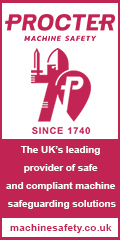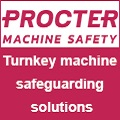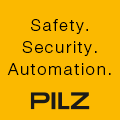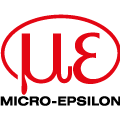
Posted to News on 14th May 2014, 20:38
What are the changes to IEC 61496-1 (EN 61496-1)?
The capabilities of light curtains and other optically-based ESPE (electro sensitive protective equipment or devices) have been something of a grey area in the past when assessing SIL levels to IEC 62061 or performance levels to ISO 13849. Now substantial revisions to IEC 61496 (EN 61496) at the start of 2014 are attempting to put that right. Dr Martin Kidman, a Safety Specialist at SICK (UK), answers the question 'What are the changes to IEC 61496-1?' and explains how the changes affect the selection of appropriate protective devices in relation to the required performance level of the safety function.

The relationship between a functional safety system's safety integrity level (SIL - as per IEC 62061 / EN 62061) and performance levels (PL - as per EN ISO 13849) and those of the opto-electronic device described by Type, has now been defined in the revised standard (IEC 61496-1:2014 / EN 61496-1:2013, Safety of machinery - Electro-sensitive protective equipment - Part 1: General requirements and tests), which supersedes the 2004 versions and their amendments on 10 May 2015.
With this defined relationship and an appropriate risk assessment, electro-sensitive protective equipment (ESPE) can be chosen to ensure the appropriate level of risk reduction and convergence with the functional safety standards ISO 13849-1 and IEC 62061.
In practice, this revision affects the previously widespread use of Type 2 safety light curtains in applications that specially require safety integrity level SIL 2 or performance level PL d.
Selecting an opto-electronic protective device
Once the required system safety level has been determined, as per IEC 62061 (SIL) or ISO 13849 (PL), the protective measures must be specified and implemented. An opto-electronic protective device has specific criteria which must be carefully assessed to achieve the required risk reduction level, including detection capability and reliability that IEC 62061 and ISO 13849 do not address fully.
A device's systemic detection capability describes its reliability in detection of certain size objects (eg 14, 30 and 40mm for safety light curtains) and subsequent switching of the outputs (OSSDs or safety-related data interfaces). This capability defines its use - for example, for detecting fingers, hands or bodies - and the minimum distance to the hazardous point. The safety level, based on the type classification, also assesses the reliability of detection.
Optical sources have potential interference from sunlight, different lamp types, devices of the same design, reflective surfaces, misalignment during normal operation or the reflective properties of various objects. Other potential risk sources include error behaviour and electromagnetic interference.
The new version of IEC 61496 clearly defines the relationship of the type to the PL or SIL in the context of operator protection. An opto-device must fulfil requirements both for the type in question and those of the PL and/or SIL assigned to it (see Table 1 below, which shows the types for PL or SIL according to IEC 61496-1).

In practice, IEC 62061 and ISO 13849 are often specified for electro-sensitive protective devices in addition to IEC 61496. These two standards apply to applications in machine safety and refer to the more fundamental IEC 61508 at various points.
Applications other than machinery safeguarding
If a SIL is specified according to IEC 61508, this gives the user the opportunity to apply an ESPE outside of the usual sector of mechanical engineering. Specific application requirements based on other standards (such as the process industry or railway applications) must also be checked in this context.
In Table 2 below, which shows the maximum PL and SIL classification for each type according to IEC 61496-1, the suitable safety level of an ESPE is described from the point of view of a safety-related application. If SIL/SICLCL 1 or PLr c is required, an opto-electronic protective device that corresponds to Type 2 or higher from IEC 61496-1 must be used accordingly. In this type of application also a Type 4 safety light curtain would be acceptable instead of a Type 2 since its systematic capabilities are better.
Type 3 ESPEs such as two-dimensional (2D) safety camera systems and laser scanners can be an alternative to Type 2 light curtains where a performance level of PLrd or SILCL2 is required. However, if the performance characteristics of these devices do not lend themselves to the application, then a Type 4 device remains the only option.

Harmonisation and CE marking for machinery in the EU
Using harmonised standards as described in this article enables the responsible parties to presume conformity with the requirements of the Machinery Directive 2006/42/EC. However, applying standards remains voluntary and, if the standards are not used, it is up to the manufacturer to prove compliance using other means and processes. Of course, this is very difficult and costly, except for the very experienced.
Importantly, an ESPE Type 2 device will no longer be an option in SIL 2/PLd applications if harmonised standards are fully taken into account. Proving sufficient systematic capabilities of an ESPE in a machine without using the specifications of the harmonised standard EN 61496-1 and its extensions IEC 61496-2 (applicable to single-beam, multiple-beam photoelectric safety switches and safety light curtains) and IEC 61496-3 (applicable to safety laser scanners) is complex.
Figure 1 below illustrates the options available for choosing an ESPE in accordance with the required level of risk minimisation, and with respect to the newly revised EN 61496-1. Figure 1 shows the attainable reliability of security features with opto-electronic safeguards.

Additional guidelines for choosing Type 2 or 4 for active opto-electronic protective devices (single-beam and multiple-beam photoelectric safety switches and safety light curtains) can be found in the available product standards for special machine types (C standards); see the standards list in the Official Journal of the European Union at: www.ec.europa.eu/enterprise.
IEC 61496-1:2014 - conclusions
With the implementation of IEC 61496-1:2014, using a Type 2 safety light curtain (in particular) in SIL 2 / PL d risk assessed applications will no longer be an option if harmonised standards are fully taken into account. If a SIL 2 /PL d safety level is required, a Type 4 safety light curtain (or other opto-electronic safety device) has to be used.
This means that machine builders, safety system engineers, consultants, and other relevant designers and implementers now have to look carefully at specifications for opto-electronic safety device when building new or substantially modifying existing safety systems on dangerous machinery.
Follow the link for more information about safety systems and products from Sick.
Want the latest machine building news straight to your inbox? Become a MachineBuilding member for free today >>

















